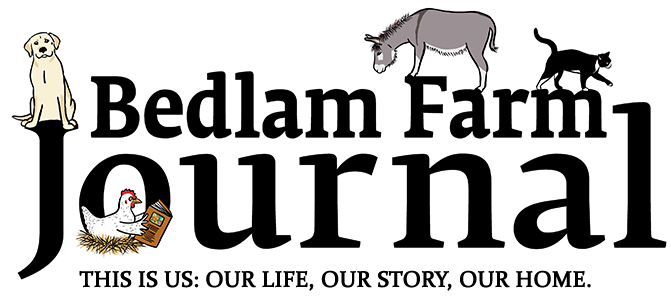Yesterday, Maria’s extraordinary empathy and connection with the animals on our farm—especially lately, the White Hen—were again powerfully displayed. She is nearing the end of her life and living comfortably in the Chicken Hospice Stall of our barn, where she is slowly but surely approaching death. It seems she’s not ready to go, and we will once again let nature take its course.
The White Hen showed us she wants to live. Maria brought her more life once again. You can see the video below and read her account of how she saved the White Hen once more on her blog.
Maria and I both love our animals, but we are very conscious of putting boundaries around that love.
Any honest vet will tell you that the worst part of their practices is dealing with dog and cat lovers who can’t let go and spend thousands of dollars, enormous time, and emotional energy on keeping their animals alive far beyond their natural life or their ability to live naturally and normally.
They hate to see animals suffer.
Maria and I both have strong feelings about what I see too often: the selfishness of people who say they love their animals but who increasingly subject them to years of pain and bewilderment due to the intense and expensive surgeries people subject them to.
Since dogs can’t give permission, we must act and think. They often undergo extreme pain without their consent or understanding.
Pets, like people, can be kept alive for years on machines and medicine. Most of us know this is cruel. Many people feel it represents love, and the surgical vets are now wealthy.
While humans are getting less health care, pets are getting more at a soaring cost. This makes me quiver to think about it.
Many animal lovers tell me surgery for their pets is kindness; I believe it’s the new form of socially acceptable animal abuse. I’m in the minority; I speak only for myself.
(Americans now spend significantly on pet surgery, with costs varying widely depending on the procedure, pet size, and location. For example, ACL repair in dogs can range from $4,000 to $6,000, while foreign body removal can cost $3,000 to $7,000. The average annual spending on pet care, including vet visits and surgery, can range from $700 to $1,500 per dog and $379 for a cat. )
Animal lovers often see this as a sign of their love and commitment. I see it as a cruel and unthinking loss of perspective. That’s not what animals are about for me.
Here’s how the White Hen was saved again.
Maria and I noticed that the White Hen had stopped eating two days ago. I made plans to put her down, something I often did but am increasingly uncomfortable doing. I feel the same way about putting dogs and cats into crates for years or for all of their life. Nothing could be more cruel for me.
I will kill an animal I believe is suffering greatly; I won’t keep it alive because of my selfish interest. The White Hen was deteriorating. We thought it was over.
While I thought about how I would kill the White Hen—I don’t need a rifle for that—Maria went to work and researched why an old hen might stop eating.
What she discovered—she accounts the story here on her blog —was that old hens often get cracks in their beaks, which grow weaker with age. When that happens, eating is too painful.
Usually, when hens stop eating, they soon die. That was what it looked like. But Maria, the most empathetic person I have ever known, dug deeper.
What, she wondered, if she poots the white hen’s feed in the water, a kind of mush. The White Hen sprang to life and began eating enthusiastically. She returned to life and ate everything Maria put in front of her. She looks healthy and alert once more. Maria took a video of this this morning.
The White Hen is special to us.
She gave us eggs for a decade and gave me lots of good photos. Photographers often attach to the people or creatures (or buildings) they photograph.
But she is still willing to live a natural life. Good for Maria. She is helping me learn what true empathy is, not to mention her mushrooming gifts as an artist. What a pleasure it is to love her.
